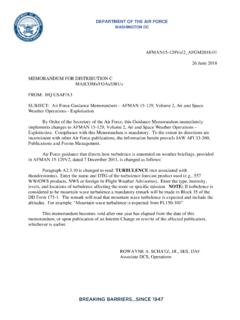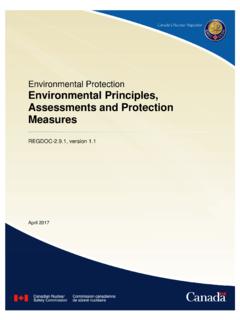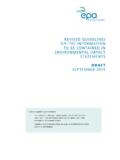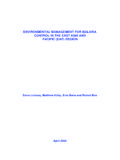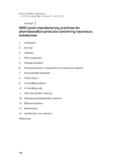Transcription of BY ORDER OF THE - AF
1 BY ORDER OF THE AIR FORCE MANUAL 48-155. SECRETARY OF THE AIR FORCE 1 OCTOBER 2008. Certified Current 16 April 2010. Aerospace Medicine OCCUPATIONAL AND environmental . HEALTH EXPOSURE CONTROLS. COMPLIANCE WITH THIS PUBLICATION IS MANDATORY. ACCESSIBILITY: Publications and forms are available on the e-Publishing website at for downloading or ordering. RELEASABILITY: There are no releasability restrictions on this publication. OPR: AFMSA/SG3PB Certified by: HQ USAF/SG3 (Maj General Loftus). Supersedes: AFOSH Std. 161-2, 26 August 1977 Pages: 15. AFOSH Std. 48-8, 1 September 1997. This Air Force Manual implements AFPD 48-1 and establishes procedures for determination of Occupational and environmental Health (OEH) exposure controls.
2 Commanders require health risk assessment data coupled with exposure control recommendations to optimize operations and eliminate Occupational and environmental Health threats or mitigate them to acceptable levels. Direction set forth in Air Force Instruction 48-145, Occupational and environmental Health Program, AFMAN 48-153, Health Risk Assessment, and AFMAN 48-154, Occupational and environmental Health Site Assessment shall be used in conjunction with this manual to assess health threats and determine control measures for OEH exposures. This manual does not provide specific guidance for disease control and containment.
3 This information is located in other references including Air Force Instruction (AFI) 48-105, Surveillance, Prevention, and Control of Diseases and Conditions of Public Health or Military Significance, AFI 10-2603, Emergency Health Powers on Air Force Installations and AFI 10- 2604, Disease Containment Planning Guidance. This manual applies to operations performed by Department of the AF civilian and military personnel, the Air National Guard, and the Air Force Reserve Command in both home station (garrison) and deployed settings. Major commands (MAJCOM), direct reporting units (DRU), and field operating agencies (FOA) may not waive any of these requirements, but may supplement this manual when additional or more stringent criteria are required.
4 This manual does not apply to government-owned, contractor-operated (GOCO) operations within the continental United States (CONUS) or United States (US) territories. These operations shall 2 AFMAN48-155 1 OCTOBER 2008. comply with 29 CFR 1910. GOCO operations located either outside the regulatory jurisdiction of the CONUS or in US territories not covered by the Occupational Safety and Health Act of 1970 shall comply with this standard in response to Air Force Federal Acquisition Regulation Supplement (AFFARS) Conflicts in guidance between this manual and other AF. or Federal directives will be reported through the MAJCOM Surgeon or DRU to AFMSA/SG3PB, 1400 Key Blvd, Rosslyn, VA 22209.
5 Refer to Air Force Instruction (AFI) 91- 301, Air Force Occupational Safety, Fire Prevention and Health (AFOSH) Program, for instructions on processing supplements and variances. Ensure that all records created as a result of processes prescribed in this publication are maintained in accordance with Air Force Manual (AFMAN) 33-363, Management of Records, and disposed of in accordance with Air Force Records Information Management System (AFRIMS) Records Disposition Schedule (RDS) located at af61a/afrims/afrims/. Refer recommended changes and questions about this publication to the Office of Primary Responsibility (OPR) using the AF IMT 847, Recommendation for Change of Publication; route AF IMT 847s from the field through the appropriate functional's chain of command.
6 The use of the name or mark of any specific manufacturer, commercial product, commodity, or service in this publication does not imply endorsement by the Air Force. SUMMARY OF CHANGES. This is the initial publication of AFMAN 48-155, Occupational and environmental Health Exposure Controls. AFMAN48-155 1 OCTOBER 2008 3. Chapter 1. Occupational and environmental Health Exposure Control Overview. Effectively anticipating, identifying and assessing Occupational and environmental Health (OEH) threats enables the identification and implementation of controls necessary to eliminate or mitigate threats from hazardous OEH exposures.
7 When determining OEH threat control options, it is imperative to follow the OEH health risk assessment guidelines outlined in AFMANs 48- 153, Health Risk Assessment and 48-154, Occupational and environmental Health Site Assessment. Figure outlines the Health Risk Assessment (HRA) and Health Risk Management (HRM) relationship. This manual focuses on the control portion of HRA/HRM. (highlighted in Figure ). A health threat, as defined in AFMAN 48-153, is a potential or actual condition that can cause short or long-term injury, illness, or death to personnel. Routine and special assessments are conducted in accordance with AFI 48-145, Air Force Occupational and environmental Health Program, to identify and assess OEH threats.
8 A health risk is the combination of an identified health threat and the vulnerability of exposure route completion to the population at risk. Health risks associated with chemical, biological, radiological, nuclear and physical threat exposure(s) may be long-term (chronic) or short-term (acute) and may be reversible or irreversible. Identifying the extent to which individual factors contribute to an OEH threat exposure is critical in the determination of exposure controls. The primary factors that can affect the intensity of an OEH exposure are: Threat source ( hazardous material used in an industrial process, emissions from an open burn pit, etc.)
9 Route of exposure (inhalation, ingestion, absorption, contact, whole body exposure). Work patterns/practices Concentration Frequency and duration of exposure Standards and Exposure Limits. Occupational and environmental Exposure Limits (OEEL) are established to protect personnel from OEH threat exposure(s). They apply to occupational and environmental exposures for individuals and/or similar exposure groups (SEG) in a particular Area of Concern (AOC). Bioenvironmental Engineering (BE) can use OEELs to evaluate the effectiveness of established controls and make recommendations to the affected commander on the acceptability of risk from OEH hazard exposures.
10 4 AFMAN48-155 1 OCTOBER 2008. Figure Health Risk Assessment and Management Relationship Health Risk Assessment Health Risk Management Locate Source Estimate Identify Review / Assess Effectiveness Risk / Level Controls /. Implement Controls Determine (Evaluate Hazard) Countermeasure Exposure Pathway Threat / Risk Analysis Define Population At Risk Assess Vulnerability Develop Course of Action Identify Health Threat / Risk Operational Context BE determines the OEEL using Air Force standards (AFIs, AFOSH standards, etc.) or the most appropriate exposure limit adopted from established, recognized standards including but not limited to the latest edition of Industrial Ventilation A Manual of Recommended Practice and Threshold Limit Values (TLVs) and Biological Exposure Indices (BEIs) , published respectively by the American Conference of Government Industrial Hygienists (ACGIH); 29.









